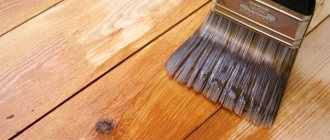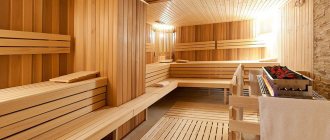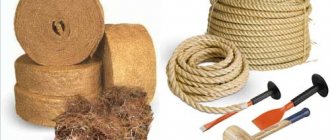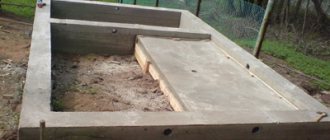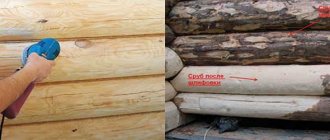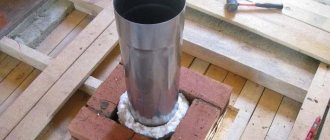Wood (or wood) is a unique natural material for building a house or bathhouse. But its disadvantage is that high humidity promotes the appearance of rot, mildew, mold, etc. It is no secret that high humidity in a bathhouse has a negative effect on wood. To protect it, it is necessary to treat it with an antiseptic. You will learn from the article which antiseptic for a bathhouse is best to use today.
Types of antiseptics and features of compositions for treating baths, saunas and bathrooms
Many people who have their own bathhouse on their property have encountered the problem of protecting wood. Our and foreign manufacturers offer a wide range of wood antiseptics both inside and outside the bathhouse.
Some antiseptics are used to treat the outside, and others inside. Their purpose is to minimize temperature differences and the effects of cold and hot water. Everyone should know that these products are not safe for human health. When choosing antiseptics, be sure to carefully study the instructions before use. A bathhouse is a room with a high fire hazard.
An antiseptic for a bath is made in most cases in the form of a solution or ointment. Its advantage is to reduce the fire of wood, because they contain certain substances that prevent the wood from catching fire.
Today there are four types of antiseptics:
- Water-soluble - they are used for preventive purposes. They should be used to treat surfaces that are not directly exposed to water and moisture.
- Oil - used to protect wood from moisture. The disadvantage of this impregnation is the increased flammability of the composition and a strong unpleasant odor. The oil composition can change the color of the wood - this is also its disadvantage.
- Combined compositions - their advantage is that they are able to protect against mold, mildew, and contain substances that protect against fire. These are so-called fire retardants.
- Organic solvents - they should be used to treat the bathhouse both inside and outside, as well as the floor in the bathhouse. A thin film of such an antiseptic covering the surface can protect the wood from negative effects on it.
Water-repellent property is the main feature of all antiseptics used in the treatment of baths, saunas or bathrooms.
What is the difference between oil impregnation and water-soluble impregnation? First of all, its foundation. Thus, water-soluble antiseptics are made on the basis of acrylic. An additional product is color, which gives the skin the desired shade.
Its disadvantage is that it is washed out of the wood structure. Regular surface treatment is required, which is an additional cost. The way to solve this problem is as follows: first you need to apply a waterproofing solution, and then use impregnation for baths and saunas.
Oil compositions are able to penetrate deeply into wood, leaving a thin film on the surface. They are durable, and in comparison with water-soluble preparations, their service life is much longer at high humidity levels in the bathhouse and sauna.
Their disadvantage is a pungent odor and toxicity, because... they contain a solvent. It is not recommended to use them in enclosed spaces without following safety rules. It is best to use this composition when treating the dressing room or walls outside, and not inside the bathhouse.
Preference should be given to odorless antiseptics used inside baths and saunas.
In terms of composition, as we can see, the best option will probably be a combined antiseptic: it will immediately be possible to protect the tree from pests and enhance its fire-retardant properties.
Depending on the composition, antiseptics are:
- Made on a wax basis. The scope of application is finishing the walls and ceilings of baths and saunas inside, where huge amounts of moisture accumulate. You need to apply such products in two layers and thoroughly ventilate the room for several days.
- The base uses paraffin oil. It is better to treat sun loungers and shelves of baths and saunas with this composition.
- Based on acrylic and wax. Used inside the entire sauna and bathhouse, excluding the treatment of sunbeds and shelves.
- Moisture-repellent fungicidal impregnation, which has disinfecting, antifungal properties and can prevent darkening.
Attention! The sauna antiseptic produced by industry today has the following universal properties: as a rule, water-repellent, protective and fire-resistant.
The bathroom in the house is an ideal place where fungus and mold arise and multiply. The main reason is high humidity. You need to combat the problem by using a bathroom antiseptic with an antimicrobial effect. One of the best on the market is “Stop, mold Olympus”. It does not contain chlorine and is safe for people.
Antiseptics
Antiseptics are poisons that kill pests. Pests can include bacteria, fungi, algae, mosses, beetles and rodents. The proper name is correct only against the first ones. All others are biocides. Against fungi - fungicides, against insects - insecticides.
There is a lot of wood in the bathhouse, and the most common threat to it is rot. This is a form of wood destruction by certain types of fungi. Therefore, antiseptic fungicides are most often used for preventive and therapeutic purposes. In addition to causing rot, fungi can be moldy and wood staining (for example, blue stain). They require different compounds than rot, but they can be complex.
Fungal infection is blue, it requires impregnation of the bathhouse with an antiseptic.
Antiseptics can be purchased in the form of primers under paintwork materials, or as an independent product. They are also divided into those intended for internal and external work. According to the type of solvent, there are water-soluble and organic solvents.
Selection rules
Here are some simple rules to follow when choosing a product:
- who is the manufacturer - it is preferable to buy the compositions of these well-known brands: a foreign manufacturer of varnishes and paints - Tikkurila or Teknos. Among the domestic brands are “Senezh”, “Neomid”, etc.;
- what surface should be treated: (floor, ceiling, benches, walls);
- composition - must kill bacteria, protect against rot and fungus;
- cost - no need to take cheap compounds. They are not able to perform several functions at the same time;
- safety - the composition must be unharmed to human health;
- impregnation consumption - for example, tree species such as oak, birch, ash, fir, larch have difficulty absorbing antiseptic. To process them you will need a minimum of funds. But pine gets soaked quickly, which means it needs more impregnation. Aspen, linden, cedar, alder - absorb impregnation on average;
- price – a good product will not be cheap.
Important! When buying an antiseptic for baths and saunas, ask the seller for a quality certificate and a Sanitary Expertise conclusion to make sure that it is not a fake.
What to do to extend the life of a tree?
Impregnation for sauna
A difficult question for bathhouse owners (I think I came up with a new term). Many people do not want to subject their pleasant golden wood to treatment with synthetic materials. Why? They believe that this disturbs the microclimate (you know, heated boards “breathe”, release phytoncides, a natural aroma, and “chemistry” kills all this). By the way, our great-grandfathers did not bother about this at all. They simply re-laid the floors, and at the same time the walls.
Now times are different and special antiseptics for baths have appeared on the market, designed for exposure to high temperatures. If you believe manufacturing companies, such as the Finnish Tikkurila, they do not emit harmful fumes.
It’s probably worth giving up the prejudice that wood for a bath should not be treated with anything. In the end, we breathe in air that is far from the same as it was 200 years ago, and the food we eat is not at all purely organic, and now our forest does not grow outside our garden (although others do).
Recommendations for processing wooden surfaces
When processing wooden surfaces, you should follow simple rules:
- The main condition that must be strictly followed is that the surface treated with an antiseptic must be clean and dry. Remember: cleanliness is the key to success. First, remove stubborn dust, dirt, varnish residues, etc.
- The treatment should be carried out after the surface has been thoroughly sanded; it should be smooth, without cracks or knots.
- Monitor the temperature in the bathhouse or sauna; it cannot be lower than 10 degrees.
- Humidity not less than 80%. Changes are undesirable. This will affect the quality of processing and drying time.
- The antiseptic is applied with a brush or spray gun. The syringe is used for hard-to-reach places.
Treatment of walls and ceilings
The walls and ceilings of baths and saunas are certainly finished with wood. The most common means is lining made from deciduous trees. Their wood is not very dense and has low thermal conductivity. When heated, the walls of the steam room, lined with wooden clapboard, do not get very hot and do not burn the skin. The walls and ceiling of the steam room are subject to high temperatures and high humidity. This has a negative effect on the wood. It warps, cracks, darkens, and fungus and mold form. Therefore, the walls and ceiling must be treated with an antiseptic.
There are many means for treating the walls and ceiling of a bathhouse. A water-borne aniseptic based on acrylic is most suitable for these purposes; it forms a transparent coating on the surface. It is water-dirt-repellent, breathable, and heat-resistant in its properties. Protects wood very well and destroys microbes.
The Sauna product can preserve the walls and ceilings of baths and saunas well. It is translucent, leaves the natural grain of the wood visible and enlivens the interior.
You can cover the walls and ceiling of the bathhouse with Supi Arctic protective agent from Tikkuril.
Application of paints and varnishes
Not every paint is suitable for painting a log house. When choosing it, they take into account, first of all, the degree of vapor permeability of the decorative layer, the type of solvent - it can be organic or aqueous, and elasticity.
The walls are treated in several layers. The color should emphasize the natural pattern and texture of the wood. Therefore, you can choose not even a tinted composition, but a translucent or transparent composition.
The main thing is that wood paint must be vapor permeable and not impede the passage of water vapor. Over time, under the influence of moisture coming from the inside, the sealed coating will collapse, become covered with bubbles and begin to peel off. Therefore, when purchasing paints and varnishes for a log house, you must carefully read the information provided by the manufacturer on the packaging. The throughput should not be less than 120 grams per m2.
Acrylic vapor-permeable varnish for exterior and interior use
An important criterion is the adhesion of paintwork materials, which ensures the strength of the decorative layer on the surface of the wood. The most suitable composition in this regard is alkyd paint.
Acrylic compositions show high vapor permeability. But when using them, it is necessary to carefully insulate the frame from the inside. Acrylic paints containing latex have greater elasticity. Silicone paint is much more expensive than acrylic varnish.
Fire retardants – fire protection
Fire-retardant impregnations protect wood from thermal destruction under the influence of fire or high temperature. The chemicals that make up fire retardants create compounds at high temperatures that prevent ignition or flame spread. Naturally, fire retardants are not a complete fire protection guarantee. They allow wooden surfaces to resist fire for a short time (about 10-15 minutes when heated to 700? C). Fire retardants are recommended to be used to protect wooden floors in rooms, attics and others. Fire retardants are represented by such brands as Neomid 530, Pirilax Fire Protection, Fire Bioshield and others.
Fire retardants - impregnations to impart fire-resistant properties
Based on their mode of action, fire-prevention impregnations are divided into 2 groups.
Fire retardants, which prevent combustion, begin to release non-flammable gases when the temperature rises. They push access to oxygen away from the surface of the wood and thereby make combustion impossible. Blocking flame retardants form a special film on the surface of the wood. When exposed to fire, this film swells and blocks the access of oxygen (necessary for combustion) to the protected surface. Paints, primers, varnishes, plasters, etc. can be applied over fire retardants. Fire-fighting impregnations are often used in combination with antiseptics. For best results, it is recommended to first apply a layer of antiseptic to the surface, then a layer of fire retardant. For example, you can use the following scheme: the first 2-3 layers are Neomid 400 antiseptic, the next 2-3 layers are Neomid 530 fire protection.
Materials and tools for work
To remove various types of contaminants, including soap scum, soot, soot, and mold, you need to stock up on special tools and materials that will help with processing. The list of these includes:
- hard brushes and sponges with no abrasive;
- cycle of sufficient sharpening;
- medium and fine grit sandpaper;
- foam sponges with long handles and washcloths;
- soft rags (preferably not synthetic), cotton and terry cloth are suitable;
- buckets, basins, water containers;
- disinfectant composition (the best cheap alternative is “Belizna” or any chlorine-containing composition);
- broom, mop with microfiber attachment;
- stepladder or stable chairs to reach the highest point for cleaning);
- liquid household chemicals, soap, sprays (a degreaser for stoves is suitable), means for internal cleaning of the firebox and chimney duct, oils for impregnation;
- personal protective equipment (mask, respirator, gloves, apron)
Steaming surfaces in a steam room Source archiwum.allegro.pl
Expert advice
Means to ensure bath protection must be selected according to the following criteria:
- The amount of money available to the owner of the bathhouse.
- From the wood used in construction (some species need less protection, others more intensively).
- On the temperature that will be in the steam room. It is better to purchase products for internal use that can withstand up to 1000 or more.
- Depending on the condition of the bathhouse, if it has just been rebuilt, then minimal preventive protection will be needed, but if the wood is already damaged, then full comprehensive protection should be carried out.
Our domestic manufacturers also have good antiseptic and other protective compounds. For example, from the manufacturers Neomid. They make products that are safe for people, but harmful to mold, mildew, insects and other wood pests. Their antiseptic agents can perform three functions at once:
- Protect wooden material from the formation of biological pests and also eliminate them.
- Make the wood of the bathhouse fire-resistant.
- And provide the wooden material with a beautiful decorative coating.
The treatment of the steam room and bathhouse as a whole must be done correctly and efficiently. First, the walls and ceiling are processed, then the floor and doors. Work should be carried out in protective clothing, and preferably with glasses. Use high-quality brushes and brushes so that the treatment is carried out completely over the entire surface. It is recommended to apply protective compounds in several layers, allowing the previous one to dry completely.
Preparatory stage
Before you start washing the surfaces in the steam room, you must first prepare everything. This process consists of several standard steps:
- Removing items, stools, bath furniture (if available) and other accessories for the steam room (panama hats, brooms, soap compositions). It is important to exclude all objects that may interfere with cleaning.
- Removing cobwebs from ceilings, sweeping dust off walls, removing leftover leaves from brooms and other debris from shelves.
- Cleaning the stove (if its firebox is located directly in the steam room), ash and other combustion products are completely removed from it.
- Sweeping the floor, if necessary, pre-wash it with liquid soap (soap or a special composition for wooden floors).
After the above steps are completed, you can begin processing the internal surfaces.
On a note! When choosing cleaning products, remember that they should not harm the wood from which the bathhouse is made.
Video description
Bathhouse like new after cleaning
Budget "Whiteness"
“Whiteness” contains chlorine in its composition, therefore it is also an excellent disinfectant, but it must be used with caution, as it can discolor surfaces. To prepare the cleaning product, do the following:
- prepare 25 milliliters of alcohol, bleach, diluted copper sulfate, “Whiteness” and 25 percent formaldehyde.
- prepare one liter of water and add to it all the ingredients listed in the first paragraph;
- be sure to choose a metal container for mixing (you can use an enamel container), then take a clean sponge or rag and soak it in the prepared mixture;
- Thoroughly wipe off all dirt with the solution, then rinse. Under no circumstances leave this composition on the ceiling until completely dry. This can cause stains that cannot be removed later.
These are the easiest ways to remove dirt from the ceiling using budget funds.
White for cleaning bath surfaces Source skladupakovki.ru
Purchase method
Special-purpose sauna chemicals can be purchased in the traditional way - bought in a store. Or you can order online. There are many sites, one of the directions of which is the sale of safe bath detergent . By choosing the latter method, you will save your time, and perhaps even your money. But in the store you can directly get acquainted with the product, evaluate the integrity of the packaging, you won’t have to wait long for the moment when you can put the purchased product into use, evaluate the effectiveness and result.(
Quarantine zones inside the bathhouse
First of all, it is worth deciding how and where to properly use the antiseptic inside the bathhouse. Any bathhouse consists of at least four main rooms:
- Entrance room and locker room;
- Restroom;
- Washing or shower rooms;
- Steam room.
Inside each room of the bathhouse there are completely different conditions, therefore the methods of using antiseptics or disinfectants are completely different.
Inside the dressing room and hallway, the conditions are approximately similar, so to treat wood cladding and especially the floor, you can and should use the usual antiseptic options for interior living rooms. The higher quality the drug, the better. You can use the antiseptic Senezha, Neomid or more expensive Finnish preparations for working inside buildings manufactured by Tikkurila.
With proper ventilation and regular sanitary treatment of the wooden floor and walls, fungus or blue rot, any similar pathogenic microflora, even after a single high-quality treatment with an antiseptic in these rooms inside the bathhouse, is doomed to destruction.
Fire protection means for steel building structures and cable lines
Fire retardant coating and paints that increase the fire resistance of steel structures from 0.5 to 2.5 hours. Phoenix CE paint, which reduces the fire hazard of cable lines.
Range of fire protection means for steel building structures and cable lines:
| 1 | Fire retardant coating. 1st - 5th group of fire retardant efficiency for steel structures | OPV-1 |
| 2 | Fire retardant paint. Increasing the fire resistance of steel building structures from R30 to R90 | Defender M |
| 2 | Fire retardant paint. Increasing the fire resistance of steel building structures from R45 to R90 | Defender M Solvent |
| 2 | Fire retardant paint. Increasing the fire resistance of steel building structures from R30 to R90 | Phoenix STS |
| 2 | Fire retardant paint. Increasing the fire resistance of steel building structures from R30 to R90 | Phoenix STV |
| 3 | Fire retardant paint. Fire protection agent for cable lines | Phoenix SE |
Fire retardant consumption
Each fire retardant composition is unique and interacts differently with wood. Therefore, the consumption of such compositions can only be determined through special pilot tests.
Moreover, production losses in this case are also taken into account.
- Ultimately, certificates for fire retardants specify their maximum, minimum and average consumption per 1 m2.
- However, real figures in practice may turn out to be much higher than those indicated in the documents.
- Because this indicator depends on a significant number of factors - the density of the wood, the ambient temperature, and the level of humidity.
Even how carefully a particular person carries out the procedure for applying a particular composition plays a role.

